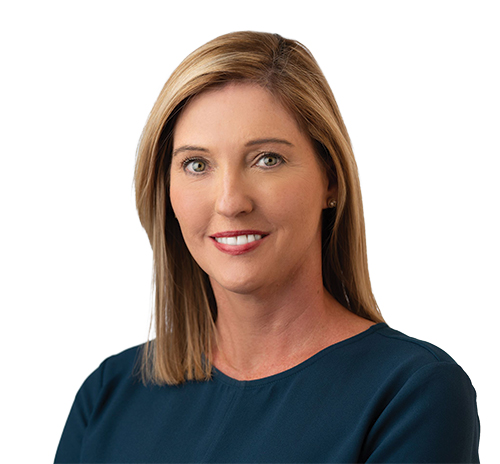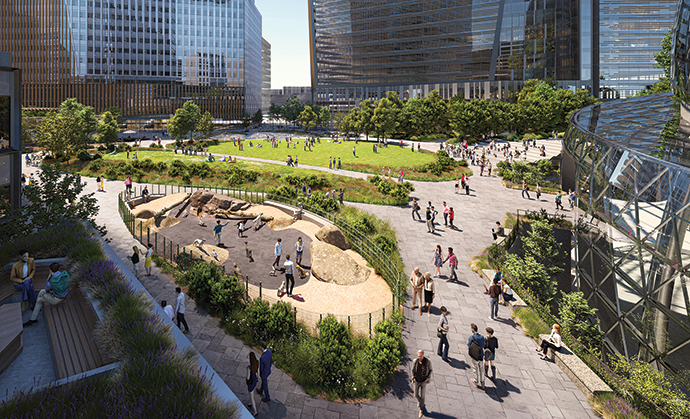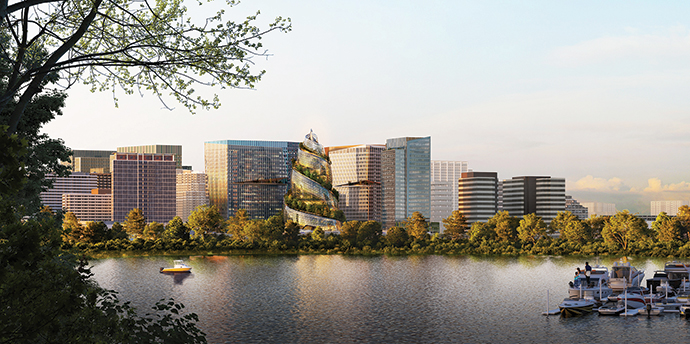If it seems like Amazon opens a new facility every other day, that’s about right.
From New Year’s Day 2020 until early 2021, Site Selection’s Conway Data Projects Database tracked 180 Amazon facility investments worldwide. Those projects join a global portfolio that as of December 31, 2020, was closing in on 475 million sq. ft., which equates to more than 10,893 acres or 17 square miles — just a smidgen smaller than the country of San Marino in Italy, and about half the size of Bessemer, Alabama, where Amazon fulfillment center employees recently voted not to join a union.
A new year hasn’t slowed the pace of Amazon projects. Among the latest:
- 3,000 more jobs at the company’s tech hub in Boston;
- A new last-mile facility in Bakersfield, California, and a new delivery station in Slidell, Louisiana, a state where the company is building fulfillment centers at the former Evangeline Downs racetrack and at a former mall in Baton Rouge;
- The company’s 10th Indiana fulfillment center (code-named “Project Mastodon”) coming to Fort Wayne, and a 1,000-job fulfillment center coming to Greater Richmond, Virginia;
- Five new buildings and 2,000 new full- and part-time jobs in metro Detroit;
- New Amazon Web Services infrastructure regions in Japan, Australia and India;
- A new office tower in Bellevue, Washington;
- The company’s first-ever purchase of 11 Boeing 767-300 aircraft, expanding its Amazon Air fleet as it expands air operations worldwide;
- A 500-job fulfillment center in Amarillo, Texas, in a state where the company has created more than 70,000 jobs since 2010 with facilities that include 17 fulfillment and sortation centers, 10 delivery stations, three tech hubs, three air gateways, one regional air hub and, for good measure, a wind farm.
Honestly, it’s hard to keep up.
But if it seems hard to us, imagine the challenges for Amazon Head of Worldwide Economic Development Holly Sullivan. Late in 2020, Amazon reached out to me about a potential interview with Sullivan, a former economic development leader in Tennessee. (Oh yeah, Tennessee in February welcomed a new fulfillment center in Alcoa, the company’s sixth in the state and third new announcement within a year.)
An edited version of our conversation follows. Visit siteselection.com in May for the full transcript.
No employer comes close to creating the number of jobs Amazon has since the onset of the pandemic. What has it been like to be part of this tremendous wave of job creation that takes place in such an atmosphere of health risk?
Holly Sullivan: It’s been an incredible opportunity and a huge responsibility to not only deliver for the communities and continue creating jobs, but to invest to make sure we’re keeping our employees safe. At the onset of the pandemic, we were very customer focused. “How do we get these essential items from point A to point B as efficiently and safely as possible?” Then we looked at how can we make sure we’re keeping employees safe: We immediately put in over 150 different processes, investing billions of dollars, following guidelines from federal and local health authorities, the CDC, the WHO. We brought in our own experts and hired independent epidemiologists to make sure we’re providing a safe and healthy working environment.
How do you manage the Amazon real estate and site portfolio?
Sullivan: All of our investment decisions include a cross-functional team. My team comes in at different times in the process. On the corporate side, we’re always looking at how we can expand and evaluate the office footprint based on the business needs, and at where we should make those additional investments. We’re always working backwards from the customer, which I think is unique to Amazon: What additional innovations are we looking at, and how do we look around those corners to make sure we’re investing in the right team? With our corporate offices through the years we’ve learned that we tend to locate in more urban areas, and we like to go into areas where it’s not yet a campus environment. We want to mold into an existing neighborhood, whether that’s a central business district or a suburban, high-density office area like Austin, Texas, where you have the restaurants and an 18-hour entertainment area. Not only for our employees, but as we’re investing in these neighborhoods, it really benefits the entire community.

On the operations side, which is our fulfillment centers, we really focus on where our customer density is. We work backwards from there on where there are customers, where we need to double down or triple down, and what types of facilities we will locate there. Across the board, there are two things that will drive most of our business decisions. One is ensuring we can have that initial day one talent, and where we can invest in the long-term talent pipeline. Number two would be business friendliness. We want to locate and invest in communities that want us and can support us in the long term, and where we can build a long-term community partnership.
We also don’t tend to look too far out. As we are looking at these decisions, we’re looking in windows of three to five years, and then we can make those decisions based on real-time data and marrying the data with anecdotal information. We have a lot of experience in global locations. We can take that experience and narrative back to help guide our site selection process.
Share an update about HQ2: What have you learned along the way?
Sullivan: We’ve started construction at our second headquarters. Metropolitan Park was our first phase of 2 million square feet. That was approved in December 2019. We’re fully under construction there. Our second phase is called Penn Place. That is now going through approvals in the coming months, will take a couple years of construction and should be complete by 2025. We have hired over 1,600, and we have over 1,000 job openings. We understood the importance of those community relationships, and I think this project has really validated that engagement, how “early and often” are important.
I remember walking into a meeting of several joint neighborhood associations, and I was a little nervous. There was a presentation and update, and then 45 minutes to an hour for questions. There were several hundred people in that meeting room. I left that meeting and remember feeling relieved, but thankful I was given the opportunity to answer their difficult questions, and thankful that they listened. I think what was surprising to most was when we made our decision to locate our second headquarters in Arlington, there was an assumption it was a fully baked plan — that we had our development plan down and we were going to put a shovel in the ground the next day.
But that isn’t how we make a decision, and it’s not really how we work. Once we made a decision to locate in Arlington, we met with the county board, community stakeholders, neighborhood associations, the county staff. We really wanted to hear their input. That went into our decisions on our work with our development partner and architects on what the Arlington headquarters would look like. It’s not just wanting to go into a community and develop our site. We really want to integrate into the fabric of that neighborhood, really stitch ourselves into it, create that 18-hour neighborhood and be an addition.
Everyone knows about HQ2, but not as many may be familiar with the giant HQ campus in Hyderabad, India.
Sullivan: The Indian example is prototypical of how we make these decisions. When you look at India, it was really an opportunity to deliver for our customers. We understood the local talent opportunities there and that was a key factor. Over the last seven years, the Indian customer began to value convenience and online shopping. It was incumbent on us to look at how we continue long-term investments and opportunities. Our India team is amazing, first of all, in their innovations and what they’re able to not only provide customers in India but on a global basis. Our new corporate office there is over 9.5 acres and will support more than 15,000 employees. It is our first owned office building outside of the U.S. I think this will continue to strengthen our talent in India, and really create that tech base outside the United States for global innovation.
You’re growing fast in Ireland too. Where else are you looking to ramp up abroad?
Sullivan: India, Ireland, Australia, Singapore, Canadian locations, Costa Rica — those are some of our larger corporate offices. Cape Town, South Africa, would also be included in that list.
Amazon has launched a $2 billion housing equity fund. Describe how Amazon’s new focus on housing affordability and equity is part of your commitment to community.
Sullivan: I would push back on the premise of “new.” We’ve been focused on homelessness and housing affordability for years. We were one of the early investors in Mary’s Place, a homeless shelter in Seattle. We provided space for years, and now they have a permanent home in one of our headquarters buildings in downtown Seattle. [Amazon founder Jeff Bezos visited Mary’s Place this spring to mark the site’s first anniversary.] We’re long-term partners with Fair Start, a fabulous story and amazing organization that takes previously incarcerated people and gives them front-of-the-house and back-of-the-house skills in the restaurant industry. We have a Fair Start restaurant in one of our retail spaces at our headquarters. We’ve done housing matches. We’ve been part of the Seattle affordable housing discussion for years and years.

What is new is our new housing equity fund. That puts economies of scale into a much bigger conversation. We’re now focusing outside of the Puget Sound area on other locations in the United States. The goal is really about funding units. We see an urgency in metro areas. I can tell you this from my experience: Most areas are experiencing affordability issues now. The question for us is “How can Amazon be a good partner in that?”
One example is in Nashville, which was hit by tornadoes a year ago last week, then a global pandemic, and then a 34% property tax increase, all within six months for Nashville residents. [Amazon is investing in a 5,000-job tech hub in Nashville.] In the downtown Nashville area, there are several neighborhoods experiencing gentrification. One of the things we did was partner with a local nonprofit to provide the financial assistance so that for people still rebuilding from the tornadoes who are unable to bridge that gap with the property tax increase, there’s now a fund they can apply for to help bridge that gap.
With the housing equity fund we want to recognize that housing affordability is different in every major metro area. So how can we have that conversation about what is affordable, how can Amazon be a long-term partner, and how can we also help drive policy for long-term solutions for the local community?

